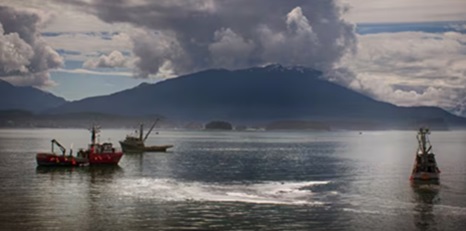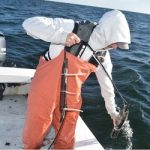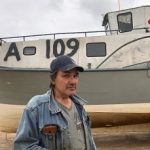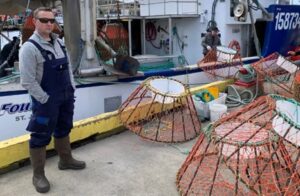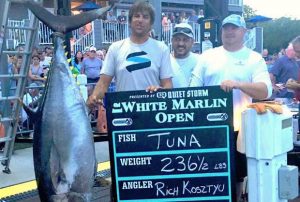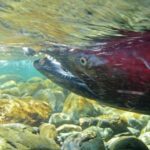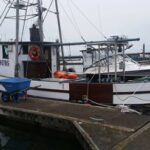Tag Archives: Pacific Salmon Treaty
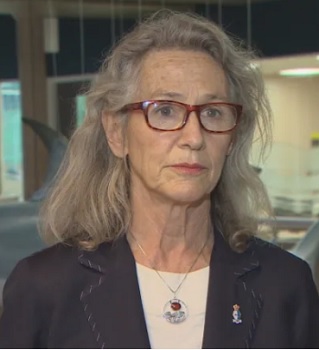
Alaskans poaching Canadian salmon top concern for federal fisheries minister
American fishing boats catching threatened Canadian salmon was flagged as a top concern for federal Fisheries Minister Joyce Murray before meeting with the U.S. ambassador to Canada in March. Over the past decade, and especially in 2021 — commercial fisheries in southeast Alaska have intercepted high numbers of Canadian salmon, particularly threatened sockeye stocks from the Nass, Skeena and Fraser rivers in B.C., the document said. The long-term rebuilding of threatened Pacific salmon stocks is a key objective for Canada, which is concerned about the potential impact a number of Alaskan fisheries are having on those stocks, the document said. >click to read< 10:47
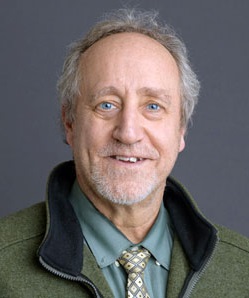
Special interest hit piece unfairly targets Southeast fisheries
I was disappointed by what I consider to be a targeted attack on Southeast Alaska salmon fisheries. A report on interceptions of British Columbia salmon in Southeast Alaska salmon fisheries was publicly released on Tuesday by Canadian environmental groups. Many Pacific salmon stocks are highly migratory and often travel across state and international borders. Several stocks migrate into Alaska’s waters to take advantage of the rich marine environment in coastal Southeast Alaska and the Gulf of Alaska where they feed and grow before starting their journey back to their natal streams to spawn. Our quality habitat allows these salmon to thrive and return healthy to their natal streams to renew their life cycle. >click to read< by Doug Vincent-Lang 13:41
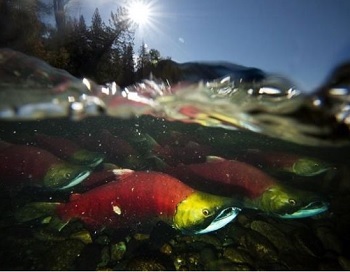
Alaskan fishing fleet catching huge proportion of B.C. salmon
As salmon runs in British Columbia hit record lows, commercial fisheries along the Alaska panhandle are catching a growing share of salmon bound for B.C. rivers, according to a new technical report. The report, which includes a detailed analysis on each B.C. salmon species caught in Southeast Alaskan interception fisheries, was commissioned by Watershed Watch Salmon Society and SkeenaWild Conservation Trust and comes as Canada and the United States begin their annual review of bilateral management under the Pacific Salmon Treaty. Many of B.C.’s largest salmon runs pass through Alaskan waters on their way home to spawn in Canadian rivers. >click to read< 11:50

Tribal fisheries advocate Lorraine Loomis of the Swinomish Indian Tribal Community has passed away
Loomis spent the last about 40 years serving the Northwest Indian Fisheries Commission, most recently as chairperson. She began her career in fisheries working in fish processing in 1970, and then became fisheries manager for her home tribe following the 1974 Boldt decision that reaffirmed tribes’ treaty-protected fishing rights.,, Chairperson of the Northwest Indian Fisheries Commission is the lead negotiator for tribes in the North of Falcon salmon fisheries planning process with the state of Washington. Loomis was also involved in developing the Pacific Salmon Treaty between the U.S. and Canada, served on the Fraser River Panel that manages sockeye and pink salmon, and encouraged local restoration and research for salmon and shellfish. >click to read< 09:13

Chinook catch falls short in first Southeast troll opening. Fleet gets a another shot.
Southeast’s commercial troll catch of king salmon fell short of its target in the first summer opening in July. The fleet gets another shot at those chinook in a second fishing period that starts Friday, Aug. 13. The region’s king salmon catch is managed under the Pacific Salmon Treaty between the U.S. and Canada. Commercial trollers had 119,300 fish remaining on this year’s allocation under that agreement going into the summer season. That leaves a target of 53,000 for the second opening. Fish and Game expects it could take seven to 10 days for the fleet to hit that mark. >click to read< 13:33
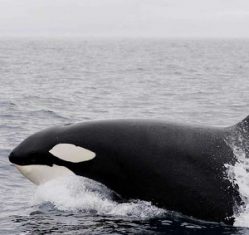
Trollers side with NMFS in Chinook litigation – Endangered whales compete with increasing populations of seals, sea lions
Litigation to halt the Southeast Alaska king salmon fishery to provide sustenance for Southern Resident Killer Whales is prompting commercial trollers to intervene in the lawsuit brought by the Washington state based Wild Fish Conservancy. The Alaska Trollers Association in Juneau voted on Tuesday, April 21, to insert itself into the defense of the lawsuit filed in mid-March against the National Marine Fisheries Service and the subsequent injunction against king salmon fishing and the troll fishery specifically. >click to read< 15:41
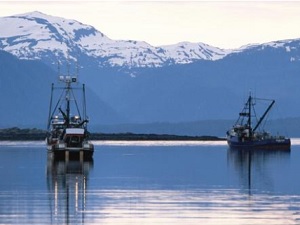
The little known United States and Canadian border war
For the past 116 years, a disputed passageway off the Alaskan coast has spurred a war between the two neighbouring countries. Though the US and Canada have the longest undefended border in the world, Dixon Entrance is one of four long-running border disputes between the friendly neighbours. The roots of the quarrel date back to the 18th Century; a time when the colonising stakeholders in the Alaskan Panhandle region (the narrow strip of mountains, fjords and channel islands bordering modern British Columbia) were England and Russia, followed by the US. >click to read< 17:37
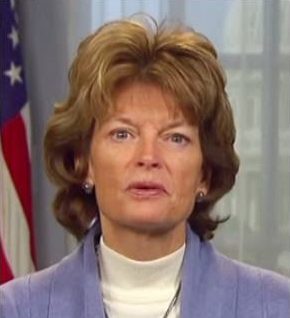
Senator Lisa Murkowski: Investing in seafood industry pays off
Alaskans know just how essential fisheries are to life in the 49th state. The seafood industry is the largest direct employer in our state, providing 60,000 jobs and generating over $5 billion for Alaska’s economy. Over 15 percent of Alaska’s working age rural residents are employed by the industry. And commercial fisheries are a cultural and economic cornerstone in small communities across the state’s 33,000 miles of shoreline. Alaska’s seafood industry also provides for our nation. Catches in Alaska make up more than 60 percent of all seafood harvests in the United States, >click to read< 15:11
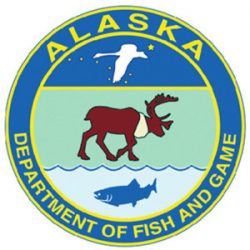
ADF&G releases terms of new Pacific Salmon Treaty
A new Pacific Salmon Treaty negotiated between the United States and Canada, and critical to fisheries and the economy of Southeast Alaska, is now in effect for the decade ahead, as state and commercial harvester entities wrestle with how to deal with it. Acting Commissioner of Fish and Game Doug Vincent-Lang notes that his agency released the actual language of the negotiated terms, which were several years in the making, to allow affected users the opportunity to review them, “especially given that the terms adopt new metrics for management of fisheries in Southeast Alaska. This was done to improve transparency,” he said on Jan. 2.>click to read<20:08
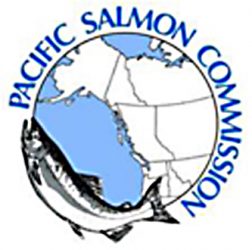
Pacific Salmon Treaty – Alaska salmon negotiators accept fewer ‘treaty fish’
For more than 30 years, the Pacific Salmon Commission has allocated salmon stocks shared between the U.S. and Canada. It’s re-negotiated every 10 years, and the latest version expires at the end of 2018. Formal talks finished in mid-August. Now, the numbers are out: Alaska will accept a 7.5 percent reduction, compared to 12.5 percent for Canada. In Washington and Oregon, the cuts range from 5 to 15 percent. “There’s some that would consider it to be winners and losers and I think in this case, I think everybody was equally disappointed,” said Alaska Fish and Game Deputy Commissioner Charlie Swanton, who headed Alaska’s delegation. >click to read<08:55
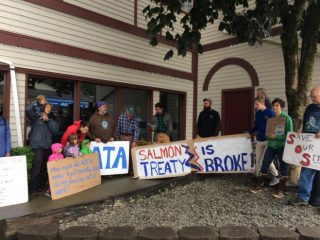
Trollers call for Murkowski’s aid with treaty
“You take our fish, you take our lives!” This is the fourth time salmon trollers have taken to the streets during the 2018 season to protest proposed cuts to the chinook harvest in the Pacific Salmon Treaty. In May, trollers gathered outside Sitka’s Centennial Building prior to the start of a state salmon symposium hosted by ADF&G Commissioner Sam Cotten. When Governor Bill Walker visited Sitka in June, dozens of fishing vessels paraded up and down the harbor, asking that Walker refuse to sign the treaty, if it forced Alaska trollers to trade a share of the king salmon harvest to Canada, to protect endangered stocks in Washington. Trollers then organized a rally in Sitka’s harbor prior to the start of the July 1 opener, where one fisherman symbolically used a flare to burn his boat payments. >click to read<17:41
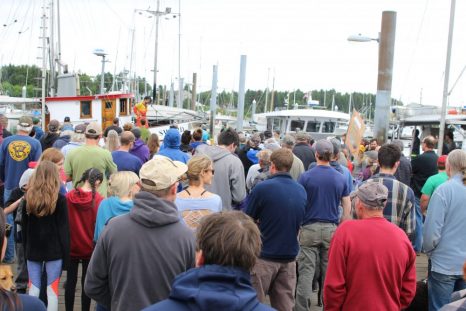
Fearing another Chinook cut, Sitka’s troll fleet calls on President Trump
Over 200 fishermen and supporters gathered at Eliason Harbor on Sunday with signs and voice raised. They made a direct appeal to President Donald Trump to get involved with Pacific Salmon Treaty negotiations. Alaskan fishermen fear the state will agree to another cut to their king salmon allocation with Canada. Fishermen don’t tend to seek the limelight. But troller Caven Pfeiffer was advised that if he wanted attention on Pacific Salmon Treaty negotiations beyond the fleet, he should consider lighting something on fire. “This is my boat payment,” he said with relish while lighting the edges. The crowd laughed with grim recognition of the financial hardship they’ve experienced in the last few years. >click to read<08:00
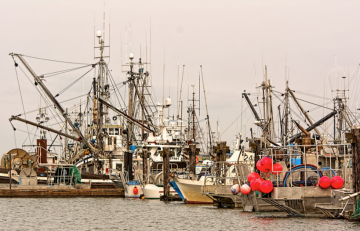
Pacific Salmon Treaty 3.0 looms for B.C. fishing industry
It has been nearly 20 years since a renegotiation of the Pacific Salmon Treaty with the U.S. sparked a war between the B.C. government, Ottawa and the U.S. That fight ended with Ottawa trying to expropriate a provincially owned seabed at Nanoose Bay – used for a joint Canadian-American submarine and torpedo test range – and generated such hostility that angry B.C. fishermen corralled an American ferry and held it hostage for two days in Prince Rupert in 1997.,,, The treaty expires at the end of this year. American and Canadian negotiators have been quietly working on its renewal for 18 months, said Brian Riddell, who is a Canadian commissioner to the Pacific Salmon Commission. >click to read<18:49
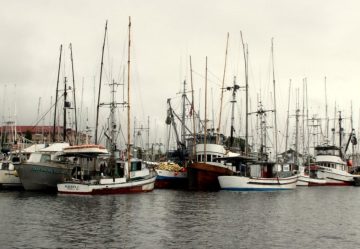
Forum to examine politics behind Alaska’s chinook conservation problem
Southeast salmon fishermen are pushing back against deep restrictions in the king harvest this season, saying the problem is as much political as it is biological. The fishing advocacy group Chinook Futures Coalition is holding a forum in Sitka this Wednesday afternoon (3 p.m. – 5 p.m. Wednesday, March 21, Harrigan Centennial Hall) to shed light on how negotiations with Canada have disadvantaged Alaskan fishermen — even as the state works to address a serious conservation problem.>click to read< 21:19
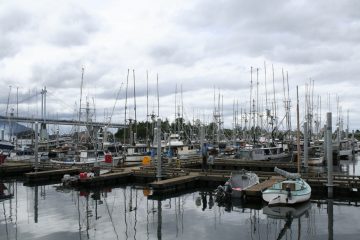
Chinook action plan a ‘question mark’ for conservation and economics
There will be a lot less fishing for king salmon in Southeast in the coming season, after the Alaska Board of Fisheries took dramatic steps to protect dwindling chinook returns to the region’s major river systems. Before wrapping up its 13-day meeting in Sitka on Tuesday, the Board of Fish passed an “action plan” intended to reverse the downward spiral in Alaska’s wild king salmon. The plan targets three primary rivers — or stocks of concern — but leaves the door open for similar conservation measures elsewhere, should they become necessary. >click here to read< 09:29
Stikine sockeye run is the best return in a decade
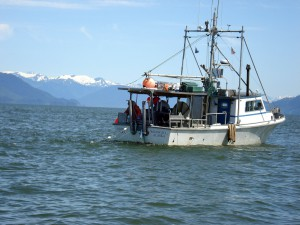 While the King salmon run for gill netters turned out to be worse than preseason estimates, the opposite holds true for sockeye. The state managed sockeye fishery began June 13. Biologists predicted a strong run but were cautious for the first few weeks to let more King salmon into the Stikine River. They limited openings to two days a week and prohibited fishing near the river’s opening. After most of the Stikine Kings passed, managers saw that the sockeye run was coming in strong. Troy Thynes is the Area Management biologist with the Alaska Department of Fish and Game based in Petersburg. “Sockeye’s are looking pretty good this year, at least locally,” Thynes said. “We’re fairly certain that we’re going to exceed preseason expectations. Especially with the Taltan River component of the run that came in really, really strong.” Stikine sockeye are shared equally between the U.S. and Canada because the river runs through both countries. It’s part of the Pacific Salmon Treaty. Canada has taken about 69,000 sockeye and U.S. fishermen 66,000. Audio, read the rest here 12:33
While the King salmon run for gill netters turned out to be worse than preseason estimates, the opposite holds true for sockeye. The state managed sockeye fishery began June 13. Biologists predicted a strong run but were cautious for the first few weeks to let more King salmon into the Stikine River. They limited openings to two days a week and prohibited fishing near the river’s opening. After most of the Stikine Kings passed, managers saw that the sockeye run was coming in strong. Troy Thynes is the Area Management biologist with the Alaska Department of Fish and Game based in Petersburg. “Sockeye’s are looking pretty good this year, at least locally,” Thynes said. “We’re fairly certain that we’re going to exceed preseason expectations. Especially with the Taltan River component of the run that came in really, really strong.” Stikine sockeye are shared equally between the U.S. and Canada because the river runs through both countries. It’s part of the Pacific Salmon Treaty. Canada has taken about 69,000 sockeye and U.S. fishermen 66,000. Audio, read the rest here 12:33
Pacific Salmon Foundation – Health of salmon not determined by catch counts
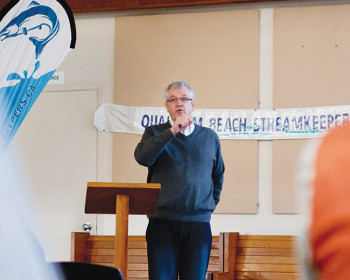 B.C. fishermen may have to console themselves with limited harvest of salmon in the coming years, but the long-term prospects for wild Pacific salmon are not as dire as some critics claim, the head of the Pacific Salmon Foundation told members of the Qualicum Beach Streamkeepers during their annual general meeting Saturday at St. Stephen’s United Church. “If you’re interested in the future of salmon, it’s better than indicated by what people talk about in the media,” said Brian Riddell, CEO and president of the PSF and a former staffer with Fisheries and Oceans Canada. “In the past, people have been fixated on catch as the measure of abundance and health of salmon. But the health of salmon is not determined by the catch. It’s determined by the amount of fish that come back and spawn after the catch.” Read the rest here 13:31
B.C. fishermen may have to console themselves with limited harvest of salmon in the coming years, but the long-term prospects for wild Pacific salmon are not as dire as some critics claim, the head of the Pacific Salmon Foundation told members of the Qualicum Beach Streamkeepers during their annual general meeting Saturday at St. Stephen’s United Church. “If you’re interested in the future of salmon, it’s better than indicated by what people talk about in the media,” said Brian Riddell, CEO and president of the PSF and a former staffer with Fisheries and Oceans Canada. “In the past, people have been fixated on catch as the measure of abundance and health of salmon. But the health of salmon is not determined by the catch. It’s determined by the amount of fish that come back and spawn after the catch.” Read the rest here 13:31
Canada and the United States have ratified an agreement on updates updates to the Pacific Salmon Treaty
 The Honourable Gail Shea, Minister of Fisheries and Oceans, announced today that Canada and the United States have ratified an agreement on updates to the Pacific Salmon Treaty (PST). These changes will help ensure the long-term sustainability of Fraser River sockeye and pink salmon stocks while supporting an economically viable fishing industry on both sides of the Canada-U.S. border. Read more here 22:20
The Honourable Gail Shea, Minister of Fisheries and Oceans, announced today that Canada and the United States have ratified an agreement on updates to the Pacific Salmon Treaty (PST). These changes will help ensure the long-term sustainability of Fraser River sockeye and pink salmon stocks while supporting an economically viable fishing industry on both sides of the Canada-U.S. border. Read more here 22:20
Southeast Alaska King Salmon All Gear Harvest Quota Jumps to 439,400 fish
 The allowable harvest of Chinook salmon covered under provisions of the Pacific Salmon Treaty will be 439,400 fish this year, up from 176,000 fish in 2013 and 266,800 fish in 2012. The quota was announced April 1 by state of Alaska fisheries biologists at Sitka. Read more here 18:25 Also, NIOSH Video Highlights the Use of Personal Flotation Devices in Cold Water Survival in Alaska, Today’s Catch – Wild on the Columbia, and more.
The allowable harvest of Chinook salmon covered under provisions of the Pacific Salmon Treaty will be 439,400 fish this year, up from 176,000 fish in 2013 and 266,800 fish in 2012. The quota was announced April 1 by state of Alaska fisheries biologists at Sitka. Read more here 18:25 Also, NIOSH Video Highlights the Use of Personal Flotation Devices in Cold Water Survival in Alaska, Today’s Catch – Wild on the Columbia, and more.
Yukon River king salmon run called “dismal”
As of Tuesday, only about 20,000 kings had been counted past a sonar located 16 miles from the Canadian border near Eagle. The Pacific Salmon Treaty between Alaska and Canada calls for a minimum of 42,500 kings at the sonar. continued@newsminer
ADF&G Announces 2013 Southeast Alaska Chinook Salmon Harvest Quota
(SitNews) Ketchikan, Alaska – Under provisions of the Pacific Salmon Treaty, the Alaska Department of Fish and Game (ADF&G) announced that the preseason Chinook salmon all-gear harvest quota for Southeast Alaska in 2013 is 176,000 fish. This year’s quota is 90,000 fish lower than the 2012 allowable preseason Chinook all-gear harvest level of 266,800. continued






